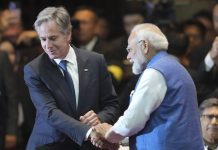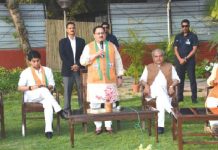 Though London-based artist Balraj Khanna is famous for his abstract paintings, in his latest novel – Line of Blood — he writes about the Partition with such heady details as though he had witnessed them from close quarters and is well aware of the upheavals that took place during those turbulent times. There are no abstract relays or indirect references. On the contrary, he chooses a locale in the undivided Punjab, Puranapur, where his characters come alive along with the connecting offshoots of the prevailing political scenario — the religious strains and the Hindu-Muslim factor.
Though London-based artist Balraj Khanna is famous for his abstract paintings, in his latest novel – Line of Blood — he writes about the Partition with such heady details as though he had witnessed them from close quarters and is well aware of the upheavals that took place during those turbulent times. There are no abstract relays or indirect references. On the contrary, he chooses a locale in the undivided Punjab, Puranapur, where his characters come alive along with the connecting offshoots of the prevailing political scenario — the religious strains and the Hindu-Muslim factor.
Of course, hundreds of volumes have been written on the Partition and each writer has portrayed that phase from his or her perspective, based either on personal experiences or narratives or a combination of the two. Perhaps, the only common thread is that the Partition had brought about disasters of such severity that they linger on till date, hovering not just around the lives of those living on the subcontinent but also denting the political climate.
In his book, Khanna manages to portray the phase of Partition through mastery of dialogues and human interactions. There are none of those hackneyed sermons or dissections, yet ground realities hold strong. Little wonder that literary giant Paul Pickering has hailed Khanna’s book with these rather apt words — “There is a magnificence about this book which makes one think of Tolstoy…”
 Also, Khanna’s descriptions of Punjab are heady, taking the reader right into the lanes and fields of Puranapur and with that into the lives of the characters. Not missing out on the minutest details, he manages to hold out an array of images — all very middle-class, brimming with that essential connect. Such is the power of his descriptive passages and also of the conversations between his characters that a reader sitting in Kerala or Uttar Pradesh or even beyond will connect to Puranapur and its people and their lives.
Also, Khanna’s descriptions of Punjab are heady, taking the reader right into the lanes and fields of Puranapur and with that into the lives of the characters. Not missing out on the minutest details, he manages to hold out an array of images — all very middle-class, brimming with that essential connect. Such is the power of his descriptive passages and also of the conversations between his characters that a reader sitting in Kerala or Uttar Pradesh or even beyond will connect to Puranapur and its people and their lives.
Quoting these lines from this book to relay what I’m trying to put across — “Balla’s grandmother, Amar Dai, worked a street bhatti, on which she roasted people’s grain and turned their yellow corn into fluffy white popcorn. Her bhatti was an eighteen-inch wide hole in the ground with a two-foot iron wok covering its mouth. The wok was a quarter full of grey sand from the Ravi Canal. Logs of fire underneath it, from another hole, heated up the sand and the hot sand turned corn into popcorn in a matter of seconds. A large sieve did the rest. The likeable old woman was popular. Her fee was one anna, one sixteenth of a rupee, or a good two handfuls of wheat or corn that people brought…’
Khanna’s forte lies in the fact that he has managed to weave the political buildups with personal inputs to those living in that little township and around. This webbing and inter-webbing of the political with the personal holds out throughout this book. And this strategy works…works wonders! It keeps the reader connected to the tale right till the very end.
Over with reading this book, how I wish Khanna writes another book on the ongoing Partitioning that’s on right now in 2018 in this country. Aren’t there sufficient relays that pinpoint to the fact that we are going through upheavals, as communally charged politics is holding sway? Today there are no colonialists around to provoke us to kill each other. It’s the political mafia holding sway which is making us hate and kill one another. Yes, bloodied are our forms as violence in the name of religion and region goes about unabated. Don’t know when will this uncontrolled communal frenzy end! Or will it not end!
letters@tehelka.com













